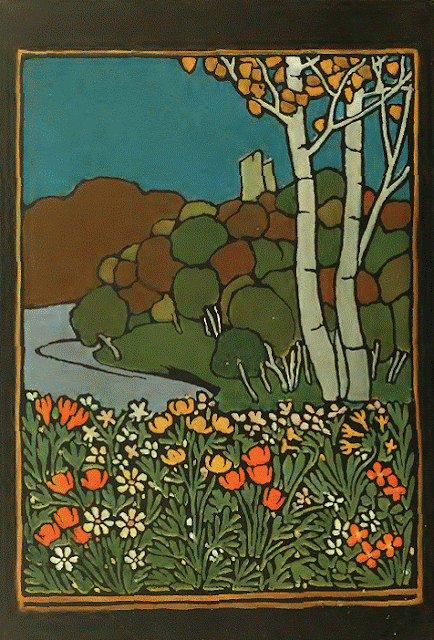Illustration: Paul Burck. Herbst im Isarthal, c1899.
The tapestry work produced by the German artist and designer Paul Burck during the last years of the nineteenth century are probably some of the most interesting examples of the new European art of that era.
Tapestry had seen a strengthening and widening of both its appeal and focus during the latter half of the nineteenth century, particularly under the leadership of the English Arts & Crafts movement. However, by the very end of the century, much of that leadership had been lost, as also had the direction of the craft, with tapestries becoming increasingly dependent on the imagery of past glories, particularly those of the sixteenth and seventeenth centuries.
Illustration: Paul Burck. Abend, c1899.
Not all tapestry within Europe had become derivative. There were innovations and fresh approaches towards tapestry work and this was more acutely seen in both Scandinavia and Germany. Scandinavia had its own particular traditional weaving history, which artists and designers used to instil ever new traditions along with those already established, producing generations of tapestry work that took the craft through the twentieth century and into the twenty first.
Tapestry design in Germany approached the subject of design and decoration in a slightly different way. In many respects, the new tapestry route was selected to follow that of printmaking and fine art, rather than that of traditional weaving. Although Art Nouveau styled poster art is often associated more with France than that of Germany, the new movement had taken great strides in introducing new ways of thinking and aspects of composition, or at least new interpretations of older traditions. Traditional German wood block printing techniques, along with engraving and illustration had expanded the world of poster art, adapting both the traditions of indigenous crafts, but also including those further afield such as Japanese printing craft techniques. However, these new ideas were also to include not only graphics, but fine art and textiles within their new remit.
Illustration: Paul Burck. Birke im Fruhling, c1899.
The five Paul Burck tapestry designs shown here obviously derive much of their styling and composition from this new input of tradition. The graphic tendencies of the tapestries could equally lend themselves to poster art or book illustration. Probably the most important element of these designs is the fact that they do not necessarily take on the appearance of the natural traditions of tapestry and so therefore, it could be said that they have broken with the history of the craft.
It is refreshing to see tapestry work from the nineteenth century that is informal, largely non-figurative and non-allegorical. Although it could be said that Burck's work is perhaps more decorative than artistic, it does give an indication of the direction crafts were to take, and particularly that of textiles, within the next two decades, so that by the Art Deco period tapestry had become part of the larger decorative format.
Illustration: Paul Burck. Dammerung, c1899.
Burck had been an original member of the Darmstadt Artist's Colony when it was founded in 1899, along with the likes of Peter Behrens, Hans Christiansen and Joseph Maria Olbrich. Although he left the colony shortly after the start of the twentieth century, it is assumed that these tapestry designs were produced while he was at Darmstadt. The colony was a hotbed of cross-pollination of ideas, theories and disciplines from some of the most talented German artists and designers of their generation. Their missionary zeal to change the face of art, architecture and design can be factored into the appearance of these tapestry pieces. Although this was only part of the creative process that produced this work at the very end of the nineteenth century, it is still a relatively powerful element of the process.
Illustration: Paul Burck. Herbstabend, c1899.
It is important to remember that the direction that Burck took with his tapestry design work was only one avenue in the larger world of tapestry craft which, b y its very nature, took many forms. However, Burck's work was still an important development in the gradual loosening of the controlling nineteenth century elements that tended to tie craft disciplines to the formal and the tried and tested. These tapestry pieces were part of the long journey that tapestry design and designers were to take throughout the following twentieth century, leading to ideas that were to take the craft along the road towards greater abstraction that would eventually lead even to a three-dimensional structural and sculptural outcome.
Further reading links:
Modern Style: Jugendstil/Art Nouveau 1899-1905
Jugendstil aus Nurnberg: Nuremberg Jugendstil
Jugendstil, Graphik und Druckkunst
Art nouveau in Munich: Masters of Jugendstil from the Stadtmuseum, Munich, and other public and private collections
Jugendstil Art Nouveau
Ornament und Illustration um 1900: Handbuch fur Bild- und Textdokumente bekannter und unbekannter Kunstler aus der Zeit des Jugendstil (Asthetik der Alltagswelt) (German Edition)
Art Nouveau: Utopia: Reconciling the Irreconcilable (Taschen's 25th Anniversary Special Editions Series)
Art Nouveau
Art Nouveau (Art and Ideas Series)
Art Nouveau, 1890-1914
Art Nouveau (Architecture and Design Library)
Art Nouveau 1890-1914
Art Nouveau (World of Art)




